|
|
|
Sort Order |
|
|
|
Items / Page
|
|
|
|
|
|
|
| Srl | Item |
| 1 |
ID:
089389
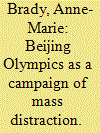

|
|
|
|
|
| Publication |
2009.
|
| Summary/Abstract |
From 2006 to 2008 the predominant theme in the Chinese media was preparations for the 2008 Olympics. These preparations were not merely about putting up new sports stadiums; China also underwent a massive public etiquette campaign, aimed at "civilizing" Chinese citizens. This was nominally so they could be good hosts during the Beijing Olympics. The 2006-08 emphasis on Olympic-related news coverage and the ongoing public morals campaign was what I have called a campaign of mass distraction: a propaganda campaign designed to mobilize the population around a common goal, and distract them from more troubling issues such as inflation, unemployment, political corruption and environmental degradation. This article discusses China's Olympics propaganda within the context of the modernization of the Chinese Communist Party's propaganda system - which has included incorporating practices originating in modern democratic states - and considers in what way changes in the propaganda system reflect changes in China's system of political control.
|
|
|
|
|
|
|
|
|
|
|
|
|
|
|
|
| 2 |
ID:
114356
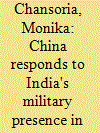

|
|
|
| 3 |
ID:
128497


|
|
|
| 4 |
ID:
189228


|
|
|
|
|
| Summary/Abstract |
As the Chinese state ramps up its efforts in international narrative competitions, Chinese media master new genres and test different visual languages on global social media platforms. The diverse content they produce provides a new source of information about China’s self-representations intended for foreigners and thus provides a condensed answer to one of the key questions of China’s foreign policy: Who is China? It also responds to the question that many observers outside of China pose: What does China’s rise mean for the rest of the world? To explain how Chinese state media use new mediums to (re)imagine China and narrate its relations with the world, this study focuses on the entertainment visual content they posted on YouTube between 2013 and 2019 to introduce and endorse Xi Jinping’s Belt and Road initiative (BRI). Using a critical discursive methodology, it decodes text-visual frames created by Chinese media to bring to the fore components of BRI’s discursive politics that are imperceptible in formal diplomatic communications.
|
|
|
|
|
|
|
|
|
|
|
|
|
|
|
|
| 5 |
ID:
139639
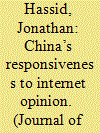

|
|
|
|
|
| Summary/Abstract |
Despite its authoritarian bent, the Chinese government quickly and actively moves to respond to public pressure over misdeeds revealed and discussed on the internet. Netizens have reacted with dismay to news about natural and man-made disasters, official corruption, abuse of the legal system and other prominent issues. Yet in spite of the sensitivity of such topics and the persistence of China’s censorship apparatus, Beijing usually acts to quickly address these problems rather than sweeping them under the rug. This paper discusses the implications of China’s responsiveness to online opinion. While the advantages of a responsive government are clear, there are also potential dangers lurking in Beijing’s quickness to be swayed by online mass opinion. First, online opinion makers are demographically skewed toward the relative “winners” in China’s economic reforms, a process that creates short-term stability but potentially ensures that in the long run the concerns of less fortunate citizens are ignored. And, second, the increasing power of internet commentary risks warping the slow, fitful – but genuine – progress that China has made in recent years toward reforming its political and legal systems.
|
|
|
|
|
|
|
|
|
|
|
|
|
|
|
|
| 6 |
ID:
135530


|
|
|
|
|
| Summary/Abstract |
As china races ahead to establish itself at the world’s pinnacle, its emergence as one of the future superpowers is seen with both astonishment and apprehension. In addition to its political, economic and strategic growth, china has also made fair advances in its media industry. The vast landscape of the Chinese media constitutes various dimensions.
|
|
|
|
|
|
|
|
|
|
|
|
|
|
|
|
| 7 |
ID:
094053
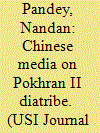

|
|
|
| 8 |
ID:
121436
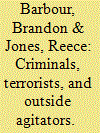

|
|
|
|
|
| Publication |
2013.
|
| Summary/Abstract |
This article is a critical geopolitical analysis of Chinese media representations of the 5 July 2009 riots in Xinjiang, China. Significant events often define the geopolitical climate by creating a space for the construction of boundaries between identity categories and the appropriate norms for behaviour towards the Other. The post-riot reports framed the event through the prism of the global war on terror to justify a violent response to protect Chinese citizens from the perceived threat of the Other. After connecting theories of narratives, the event, and group making, the article identifies three representational tropes - the criminal, the terrorist, and the outside agitator - in Chinese documents that create boundaries between the identity categories Uyghur and Han and define how the Other should be treated. The three representation tropes of the Other in the aftermath of the 5 July riots simultaneously situate the protestors as outside Chinese society and perpetuate the claim of the superiority of Chinese culture and civilisation.
|
|
|
|
|
|
|
|
|
|
|
|
|
|
|
|
| 9 |
ID:
119651
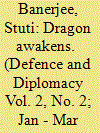

|
|
|
| 10 |
ID:
193182


|
|
|
|
|
| Summary/Abstract |
This article explores the Chinese media coverage of anti-Asian hate incidents in the USA during the COVID-19 pandemic. It sheds light on how xenophobia against Asians has been presented and discussed in the PRC press. Qualitative thematic analysis is used to identify key themes in the coverage of anti-Asian hate incidents in the two CCP-controlled newspapers: People’s Daily and Global Times. This article demonstrates that hate crimes against Asian Americans, an undoubtedly severe and complex problem for US society and politics, provide CCP-controlled media with a convenient opportunity to criticise the Other and focus on issues important to China’s identity. While blaming the discriminatory attitude in the USA towards Asians, the Chinese newspapers also use racialised stereotyping of Asian Americans as a ‘model minority’ and support the idea of Asians being alien to the USA. Remarkably, the Chinese media rarely devote special attention to victims of Chinese origin. Our observations contradict some earlier findings about discursive and reporting practices used in Chinese newspapers, that is, framing of violence and protests and selection of news sources, and showcase that these practices are pretty flexible and can adapt to better fit the particular context.
|
|
|
|
|
|
|
|
|
|
|
|
|
|
|
|
| 11 |
ID:
114572
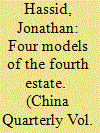

|
|
|
|
|
| Publication |
2011.
|
| Summary/Abstract |
Scholarly attention has not kept pace with the rapid changes in the professional role of Chinese journalists. Instead, two older views prevail. The first, which sees Chinese journalists as "mouthpieces" of the Communist Party unchanged from the Maoist era, downplays the tremendous changes in the media since 1978. The second view, holding that they are increasingly becoming "American-style professionals," overstates the influence of international media norms on Chinese news workers' day-to-day reality. While such communist and American-style professionals do exist in contemporary China, both are far less influential and numerous than stereotypes would suggest. Exclusive scholarly focus on these groups ignores two other more numerous and influential orientations: "advocate professionals," those who write to influence opinion and policy, and "workaday journalists," who work mainly for money and lack a commitment to public service. This article delineates all four types of Chinese journalist and explains why an understanding of the latter two professional orientations is critical to understanding China's media, politics and society.
|
|
|
|
|
|
|
|
|
|
|
|
|
|
|
|
| 12 |
ID:
123102
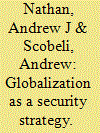

|
|
|
|
|
| Publication |
2013.
|
| Summary/Abstract |
Andrew J. Nathan AND Andrew Scobell analyze the gains and losses to Chinese security from the country's embrace of globalization in the post-Mao period. They argue that while China has grown richer and more influential, it has also been penetrated by global forces that it does not control and enmeshed in complex relationships of interdependence.
|
|
|
|
|
|
|
|
|
|
|
|
|
|
|
|
| 13 |
ID:
129993


|
|
|
| 14 |
ID:
147425


|
|
|
|
|
| Summary/Abstract |
Major advances in research on media bias have been achieved in recent years. However, methods used in the literature are primarily applied to American media and usually dependent on the two-party system. This paper attempts to detect and quantify the principal difference, or ‘media bias’, of Chinese media. We extract a document-term matrix from articles on the Eighteenth Party Congress in November 2012 from 21 Chinese newspapers from seven provinces, as well as the People's Daily. With this matrix, hierarchical clustering is subsequently used to divide newspapers into two groups. Using the dendrogram and intergroup dissimilarities, we can construct an index to indicate the direction and the magnitude of media bias. In our sample, newspapers from Zhejiang and Guangdong constitute one group, and the rest constitute the other group. The principal difference of Chinese media is reflected in two dimensions: central/local and political/economic.
|
|
|
|
|
|
|
|
|
|
|
|
|
|
|
|
| 15 |
ID:
128271
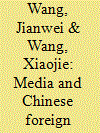

|
|
|
|
|
| Publication |
2014.
|
| Summary/Abstract |
In recent years, the relationship between the media and the foreign policy-making process in China has become more interactive and even a typical symbiosis. This paper attempts to conduct preliminary research on this very dynamic and changing relationship in the context of Sino-Japan relations. It argues that the Chinese media helps shape the agenda for foreign policy makers, narrow down the set of policy options, change the pace of policy making and implementation, and influence the direction of the final decision. Yet more often than not, the government still controls and regulates the reporting by the media on foreign policy issues. Once the media is perceived as going too far, the government never hesitates to rein it in through various internal and external mechanisms.
|
|
|
|
|
|
|
|
|
|
|
|
|
|
|
|
| 16 |
ID:
114284
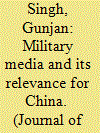

|
|
|
|
|
| Publication |
2012.
|
| Summary/Abstract |
The role of the media in China has been one where it is expected to be the 'mouthpiece' of the party. Media outlets have been used by the Chinese Communist Party (CCP) as propaganda wings and are expected to inform the people about the CCP's policies and actions. In addition, the introduction of the Internet has transformed the media landscape. There has been a steady increase in the number of Internet users and blogs in China. In 2011, the number of Internet users was around 513 million.1 Broadly, the Chinese media can be divided into three categories: the party media, the military media, and the business media. This commentary attempts to analyse the role of the military media in China.
|
|
|
|
|
|
|
|
|
|
|
|
|
|
|
|
| 17 |
ID:
154689
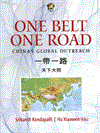

|
|
|
|
|
| Publication |
New Delhi, Pentagon Press, 2017.
|
| Description |
xvi, 438p.: tables, figures, mapshbk
|
| Standard Number |
9789386618030
|
|
|
|
|
|
|
|
|
|
|
|
Copies: C:1/I:0,R:0,Q:0
Circulation
| Accession# | Call# | Current Location | Status | Policy | Location |
| 059158 | 337.51/KON 059158 | Main | On Shelf | General | |
|
|
|
|
| 18 |
ID:
111052
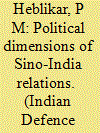

|
|
|
| 19 |
ID:
153385
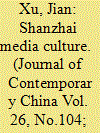

|
|
|
|
|
| Summary/Abstract |
This article studies shanzhai media culture, a specific type of shanzhai culture that copycats the most-watched shows of China Central Television (CCTV) with a sense of satire and play. The article discusses why CCTV has become a popular target of shanzhai, how CCTV’s brand shows are shanzhai-ed and what are the political implications of shanzhaing these established programs. By presenting Lao Meng’s Shanzhai Spring Festival Gala as a case study, the author argues that shanzhai media culture is a creative, participatory and Internet-facilitated grassroots media production, which attempted to resist and intervene in the power–money hegemony of CCTV underpinned by the disingenuous neoliberal logic of Chinese media. However, this culture failed to do so and has been co-opted and reshaped by the powerful logic it attempted to challenge.
|
|
|
|
|
|
|
|
|
|
|
|
|
|
|
|
| 20 |
ID:
096588
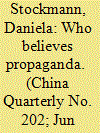

|
|
|
|
|
| Publication |
2010.
|
| Summary/Abstract |
The Chinese media have undergone commercial liberalization during the reform era. Interviews with media practitioners reveal that media reform has brought about three different types of newspapers that differ with respect to their degree of commercial liberalization. Based on a natural experiment during the anti-Japanese protests in Beijing in 2005, this article shows that urban residents found more strongly commercialized newspapers more persuasive than less commercialized newspapers. Provided that the state can enforce press restrictions when needed, commercial liberalization promotes the ability of the state to influence public opinion through the means of the news media.
|
|
|
|
|
|
|
|
|
|
|
|
|
|
|
|
|
|
|
|
|